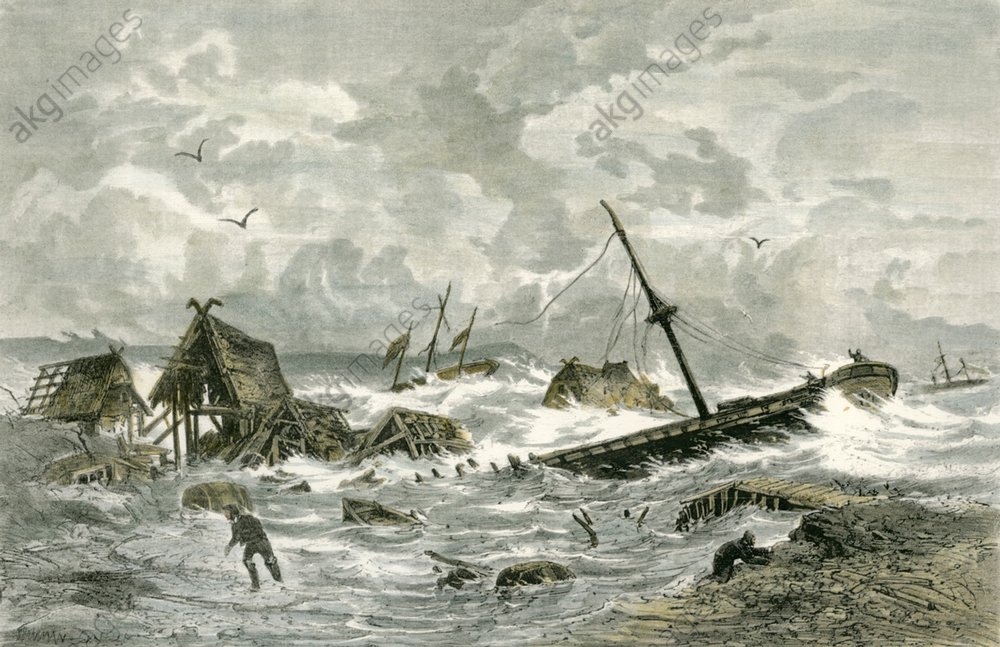1304 All Saints Flood on:
[Wikipedia]
[Google]
[Amazon]
The All Saints Day flood (german: Allerheiligenflut) of 1304 was a
storm surge
A storm surge, storm flood, tidal surge, or storm tide is a coastal flood or tsunami-like phenomenon of rising water commonly associated with low-pressure weather systems, such as cyclones. It is measured as the rise in water level above the n ...
that hit the southwestern Baltic Sea coast on 1 November ( All Saints' Day) that year. The region of Western Pomerania was particularly badly affected by the flooding. 271 people died as a result of the flood. The dating of the disaster to All Saints' Day in 1304, which gave the flood its name, goes back to the ''Stralsundische Chronik'' by Johann Berckmann (died 1560). This date is, however, not confirmed, although it is probable that the year was 1304.
Course of events
Like most similar storm floods, the All Saints Day flood arose when water accumulated in the middle and northern Baltic as a result of several days of strong westerly winds, and then surged abruptly onto the Pomeranian coast when the wind suddenly shifted to the northeast. Chronicles report a severe storm, which destroyed numerous houses and churches.Consequences
To the east of Rügen is the Mönchgut Peninsula, 8 km southeast of which is the island of Ruden, is the Greifswald Bodden threshold, which separates the Greifswald Bodden from the Baltic Sea. Some chronicles claim that there was a land connection here, which was destroyed by the All Saints Day flood, so that a new channel, 3 to 4 metres deep, was formed through the so-called Greifswald Bodden threshold and described as a new shipping lane or significant opening. The All Saints Day flood resulted in substantial losses of land between the islands of Rügen and Usedom: for example, until 1304 there was a land bridge between the peninsula of Mönchgut on Rügen and the island of Ruden off Usedom. TheBay of Greifswald
The Bay of Greifswaldinland lake and the present-day branch of the 
River Oder
The Oder ( , ; Czech, Lower Sorbian and ; ) is a river in Central Europe. It is Poland's second-longest river in total length and third-longest within its borders after the Vistula and Warta. The Oder rises in the Czech Republic and flows thr ...
, the Peenestrom, flowed on through the Strelasund and did not discharge into the Baltic until the western end of the sound. In the 1304 storm flood, the southern part of the Mönchgut and most of Ruden was flooded. Whether further storm flooding was needed to finally drown the land under the water, is not known. The only losses recorded are those of two villages on Ruden that were drowned. The Bay of Greifswald was henceforth known as the "low country" (''Landtief'') or the "New Deep" (''Neue Tief''). 300 years later, only the ever-shrinking island of Ruden remained, along with the small island of North Ruden
North is one of the four compass points or cardinal directions. It is the opposite of south and is perpendicular to east and west. ''North'' is a noun, adjective, or adverb indicating direction or geography.
Etymology
The word ''no ...
, which presumably sank beneath the waves in the 17th century. The remaining island is still less than 2 metres above the water for long stretches; the channel for the eastern approach to Stralsund
Stralsund (; Swedish: ''StrĂĄlsund''), officially the Hanseatic City of Stralsund (German: ''Hansestadt Stralsund''), is the fifth-largest city in the northeastern German federal state of Mecklenburg-Western Pomerania after Rostock, Schwerin, Neub ...
has to be dredged to be kept free.
Other consequences of the All Saints Day flood have not been handed down, but it is also possible that it led to breaches to the Baltic Sea at Damerow
Damerow is a village and a former municipality in the Vorpommern-Greifswald district, in Mecklenburg-Vorpommern, Germany. Since 1 January 2012, it is part of the municipality Rollwitz
Rollwitz is a municipality in the Vorpommern-Greifswald distr ...
on Usedom, at the Swine estuary and on the shores of the Prorer Wiek. These areas were almost uninhabited at the end of Middle Ages because of their infertility.
Due to questionable and partly contradictory traditions, the scientific literature does not agree on the facts. However, taking into account geomorphological coastal changes in recent earth history, from c. 2000 B.C. until the Middle Ages, and the location of the Mönchgraben, a border fortification, there was almost certainly a land bridge.Nils Petzholdt: ''Der Mönchgraben bei Baabe und die Landverbindung zwischen Rügen und dem Ruden'' In: ''Pommern. Zeitschrift für Kultur und Geschichte.'' Heft 1/2014, , pp. 4–8.

Chronicles
The oldest known written account of the flood is recorded in two Stralsund Chronicles from the late 15th century that were published by Rudolf Baier in 1893. Chronicles by Johannes Bugenhagen, Johannes Berckmann, Thomas Kantzow and Nicolaus von Klemptzen all reported the event. In many chronicles the descriptions of the effects of the flood are mostly exaggerated and untrue. For example, Albert Georg Schwartz, wanted to establish the loss of land on Ruden and reported the demise of two villages on the island in a document by Gottlieb Samuel Pristaff, which was revealed as a forgery after 1850. The data invented by him were disseminated by various authors and were found primarily in local literature.References
Literature
*Friedrich-Wilhelm Dwars: ''Der angebliche Landzusammenhang zwischen Rügen und dem Ruden in historischer Zeit und die Entstehung der Einfahrten am Ostrand des Greifswalder Boddens''. In: Gesellschaft für pommersche Geschichte und Altertumskunde (ed.): Baltische Studien. New Series, Vol. 45, von der Ropp, Hamburg 1958, pp. 9–26() History of Pomerania Floods in Germany History of the Baltic Sea 14th-century floods 1304 in Europe 1300s in the Holy Roman Empire Medieval weather events {{middleages-stub